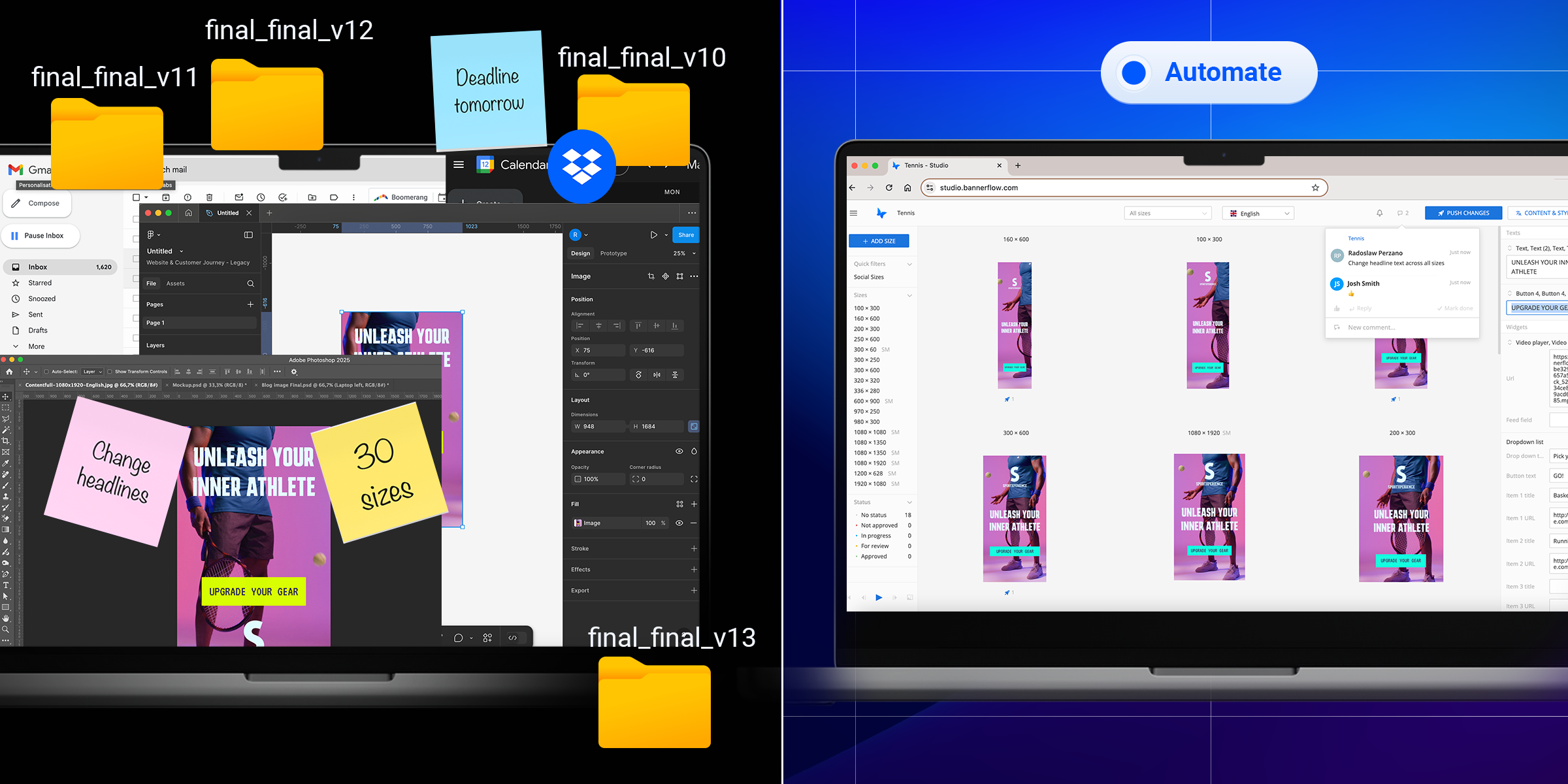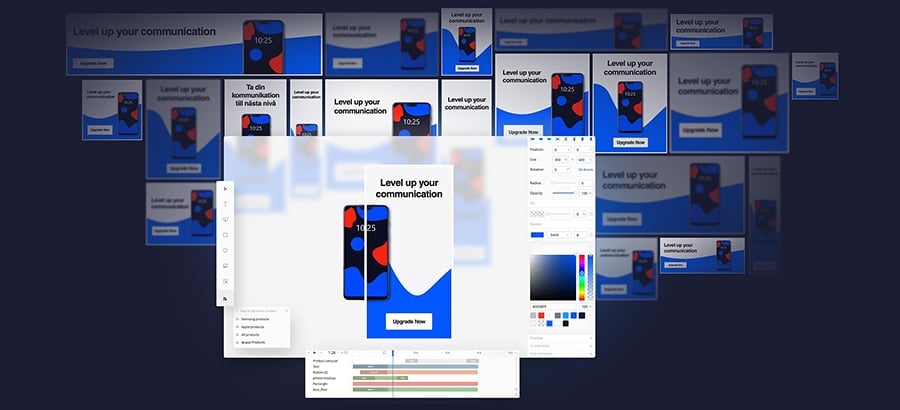Dynamic content is a fairly new phenomenon in display advertising. Indeed, there is some confusion across the industry as to its exact meaning and its application.
So let us simplify it for you.
The term ‘dynamic’ refers to the adaptability of your advertising. Each banner ad can be tailored depending upon geolocation, behavioural, demographic as well as much more.
Plus, there is a sliding scale of just how relevant, or indeed personalised, you want your advertising to be. The most advanced banners harness a form of personalisation called dynamic creative optimisation (DCO) that adjusts and optimises to create hyper-relevant advertising on the fly.
So just sit back, relax, and discover all the different ways in which online advertising can be made dynamic. And how it can be produced using the Bannerflow creative management platform (CMP).
Dynamic Feeds
Dynamic feeds are nothing new in display advertising. And they’re particularly useful for cross-selling or cart abandonment. Being able to show an ad with a product that a viewer has previously expressed interest in is an extremely effective form of dynamic ad.
With Bannerflow, all you need to do to achieve this is to link your product inventory with your master creative. The feed will then show directly in banner.
Be sure to pay attention to your pixel usage too. For retargeting cart abandonment banners, implement burn pixels for purchased items and set frequency caps to avoid irritating viewers.
Geo-location, behavioural, and demographic targeting
Dynamic ads can be adapted depending upon a range of factors. The most common of which include location, behaviour, and demographic data. But each has its uses and its application.
Geo-location
As the name suggests, geo-location based dynamic advertising is tailored based upon the location of your viewer. This particular method is useful if you’re hoping to drive in-store traffic or cater to regional differences. Typically, these sort of ads will have copy that draws attention to the location of the store or makes specific reference to a local event or place of interest to highlight its relevance to the consumer.
Behavioural
Behavioural ads are all about targeting viewers based on their browsing activity. If they’re searching for a specific product or researching a particular topic that’s where your ad excels. This type of dynamic is great for getting your product in front of the right audience and for more personalised advertising. But in the post-GDPR era, contextual targeting is a safer and more popular alternative to this.
Demographic
Demographic advertising takes advantage of first-party data to adjust ad messaging and imagery relative to the socio-economic status of your viewers. For instance, in the tourism industry, tailoring holiday packages by age group is more likely to lead to greater relevance and a greater return on investment (ROI).
How you implement these types of dynamic ads with Bannerflow is simple:
1. The process begins when you upload an .xml file with all the products, prices and information your banners need to display the right ad to the right people.
2. Next, you can create your banner using the Bannerflow targeting module. This will serve as your template and will pull products, text, and corresponding images from the .xml feed.
3. Finally, use the code that the Bannerflow platform writes for you and place it on the pages of your website that you want to retarget viewers with. This will then place a cookie in the user’s browser and the dynamic ads you designed will take it from there!
That’s how to produce dynamic advertising in three easy steps. Despite what the internet would have you believe, dynamic advertising isn’t difficult, doesn’t require a herd of developers, or huge agency fees either – certainly not with Bannerflow anyway.
Contextual targeting
Contextual targeting works to place your ad in front of the viewer in the places in which you know your prospective customers are going to be. It has risen in popularity in recent months since GDPR made the collection of 3rd party data for personalised ads far more difficult.
Indeed, a recent report by eMarketer showed the importance of relevance in capturing the attention of your viewers, but this doesn’t have to be achieved through personalisation. Which is where contextual targeting comes in.
With Bannerflow, you can create a set-up whereby the platform automatically scans a page for keywords as well as additional information to determine whether your ad is suitable for each site.
Dynamic sequential storytelling and ads that mirror the user-journey
Sequential storytelling
As the name suggests, this involves displaying advertising in a certain order. Targeting individuals with a series of ads in an order to lead them to a conclusion – hopefully a sales confirmation page!
It requires the user to agree to share their first-party data, but once they have done so you can show dynamic ads to a specific audience, at a particular frequency, and with a structured narrative.
User-journey
Dynamic ads that follow the user-journey work in a similar way, just with more precision. With an effective pixel implementation strategy, you can have your ads mirror where the viewer is in the sales funnel.
For instance, you can adjust an ad’s messaging and CTA for an individual in the last stage before purchase to encourage them to complete a purchase. Whereas someone at the awareness stage of the funnel may be more interested in a special offer or USP of a product.
Dynamic creative optimisation (DCO)
Dynamic creative optimisation is everything marketers could want of online advertising. Being able to serve the right ad, to the right person, at the right time is hyper-relevant advertising in action.
Every single one of these dynamic campaigns we’ve just mentioned is suitable for DCO. But with DCO, it’s just that the optimisation comes as standard. So ads are tailored and adjusted via an algorithm, rather than by your own hand.
To learn more about how DCO works, and how to build these adds using a CMP. Read more here or get in touch with us.
Conclusion
Dynamic advertising offers incredible opportunities for online marketing. In an age where marketing is moving towards hyper-relevant advertising, your campaigns need to use data that is available to them in order to produce campaigns that convert.
The methods available to marketers are seemingly endless and it can often seem overwhelming to know which is the right method to choose and how exactly to implement it.
However, with the Bannerflow CMP, the possibilities are within reach. See what you do – apply for a demo now.







